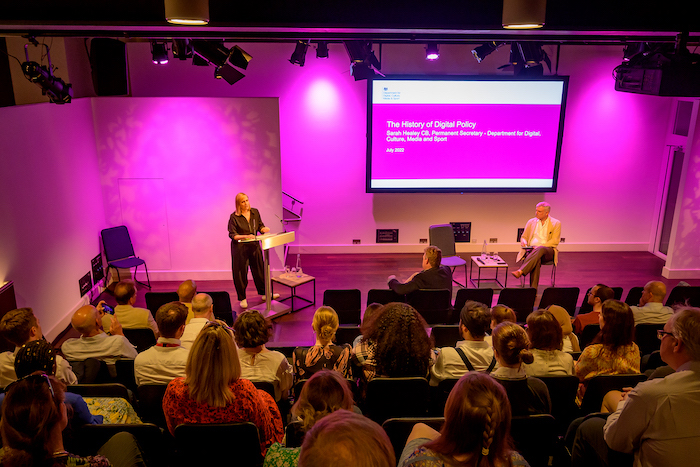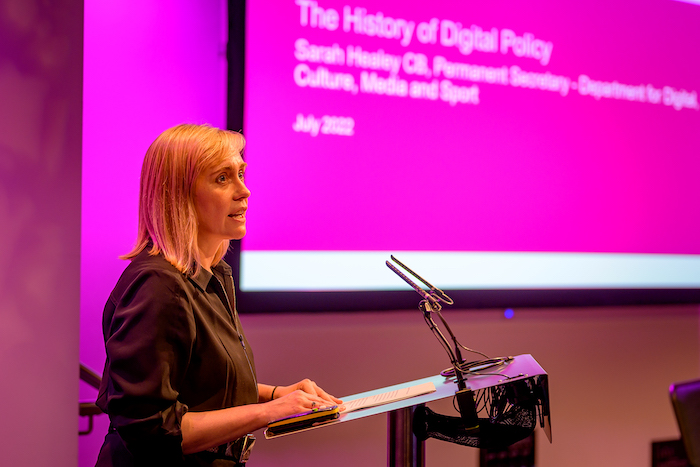The DCMS looks back through the decades at how government's approach to digital policy has evolved
In 1992, the US Congress passed the Scientific and Advanced Technology Act, paving the way for the modern internet. Meanwhile in the UK, prime minister John Major created the Department for National Heritage, bringing together responsibility for arts, sports and culture policy for the first time.
The two events – one a milestone on the road towards the digital era, the other a recognition, as Major put it at the time, that “man cannot live by GDP alone” – may not seem connected.
Yet that department – now known as the Department for Digital, Culture, Media and Sport – is playing a central part in helping government respond to the challenges and opportunities of the digital revolution. It has developed what permanent secretary Sarah Healey described in a recent speech as a “coherent, consolidated capability” for digital policymaking within the civil service.
This setup, she argued, is “almost unique among governments” and represents “an incredible asset to the UK compared to those overseas administrations who continue to suffer from a fragmented split of responsibilities on digital policy”.
Healey’s speech set out both how the UK ended up with this unique arrangement and the benefits it brings, while also acknowledging that there is still much to learn as the pace of digital change continues to quicken.
The speech marked the start of a partnership with the Strand Group, part of King’s College London, which Healey hopes will help to ensure digital policymaking in the UK continues to improve.
“There is endless commentary and analysis of how the internet has developed, how tech giants have become dominant in our economy, how technology has improved and transformed almost every industry sector and how our lives have changed now we live them online,” Healey said.
“But a lot less on how government and the public administration has responded to the impact of technology on our lives, our economy, our security and our society. While individual policies are rightly scrutinised, challenged or lauded, there is little debate about whether government and the civil service have organised themselves to set digital policy effectively.”
Healey wants, therefore, to start this conversation in a bid to keep improving the UK’s ability to make digital policy, which she defined as not about “the way government uses digital technology to deliver its own services” but “the shorthand we use for policymaking in response to the massive transformation effected by digital technology on the world we live in.”
The partnership between DCMS and the Strand Group is modelled on a similar relationship the latter has with the Treasury, which was established in 2015 because then-permanent secretary Nick (now Lord) Macpherson wanted to improve understanding of organisational and policy history among Treasury officials.
“[Macpherson] felt too much knowledge and memory was being lost and future policymaking would consequently suffer,” Healey explained. “I agree with him: historical analysis is a hugely undervalued aspect of policy analysis as undertaken by the civil service.”
The Treasury partnership began with a series of speeches given by Macpherson and now includes a wide range of events and activities such as research placements for postgraduate students working in the Treasury’s archive, producing papers which are available for officials. Civil servants are also given the opportunity to join a postgraduate course studying the history of Treasury policy work, with lectures from Macpherson alongside course leader Professor Jon Davis and guest lecturers such as Ed Balls and George Osborne.

While Macpherson’s speeches on the history of the Treasury spanned 400 years, Healey’s took in just over a decade, albeit a decade in which the pace of change has been intense. She outlined three phases of digital policymaking, starting with a period around the early 2010s when there were “pockets of isolated activity [across government] reacting to technological change largely as it was felt within existing structures”. This included Cabinet Office-led work around cybersecurity and a team in the business department looking at the digital sector, which at that point was focused as much on the older tech giants such as HP and IBM as the new online platforms. “Where there were deeper examinations, they still did not anticipate how all-consuming the change would be and how rapid,” Healey added.
This began to change in the mid-2010s, Healey argued. By 2014, DCMS and the business department were running a joint unit working on the digital economy and in this second phase, “the civil service was starting better to cover parts of the new landscape of digital policy but our efforts were still immature”.
There was still a “heavy focus on growth, but less on security and harms”, she said, and disparate policy teams were not yet able to grasp the “connections and synergies between these issues”. There were also gaps in government’s policy capability “as small teams raced to try and cover a set of issues unfolding at breakneck pace in ways we simply did not fully understand, the consequences of which were already bedded in before they had been really properly observed”.
To some extent, she argued, these were challenges faced by countries around the world, none of which had yet grasped the need for coherent digital policies. “Across all administrations, public policy efforts were limited because the internet was seen as too big, too global and too ubiquitous for a coordinated and planned response from any government alone,” she said. “There was a sense that national action could not succeed given the supranational structure of the internet and the industry that grew from it.”
In response to a question after the talk, Healey noted that this assumption was reflected among tech companies too. There was a period, she said, when many of these firms “didn’t necessarily think of themselves as being in a space that could or should be regulated”, believing they existed in “a sort of other, fleeting world where, intervention from national government isn’t relevant or possible”.
“Digital policy being homed in DCMS means it’s benefited from more ministerial attention than in a larger economic department”
In the UK, this assumption around policymaking changed “almost accidentally” in the third phase of government’s digital policy evolution. The machinery of government change which saw DCMS take on media and internet competition policy (and led to that joint DCMS and Department for Business, Innovation and Skills digital economy unit) was not part of a grand plan, but driven by then-business secretary Vince Cable’s views about Sky. However, from 2015 a series of what Healey called “enlightened machinery of government changes” began to consolidate other areas of digital policy within DCMS.
By this point, Healey had joined DCMS as a director general, under permanent secretary Sue Owen. She recalled how bringing these teams together into a single department “began to show us both how interconnected the issues were but also how many gaps remained in our coverage of digital policy”.
This led to considerable growth in DCMS’s digital capability, expanding its remit to include things such as digital identity, digital competition, AI regulation and international digital policy. It also prompted a name change to recognise these new responsibilities. The digital group within DCMS now consists of some 1,200 officials: over half of DCMS’s overall workforce and more than twice the department’s total headcount in 2015 before the new capability began to grow. Healey argued that the growth of this coherent policy capability not only means officials “can support ministers across the full span of digital policy issues” but the “capabilities can all reinforce and inform each other and so lead to better, more complete policymaking”.
This also helps government to understand the impact of digital on other areas. “DCMS can now also speak with a single, expert voice on digital policy within HMG. This has made the civil service more effective at embedding digital policy within the wider strategic objectives it can support,” Healey said.
Finally, the change has helped to build a strong relationship with the tech sector, she suggested. Having a single place in government to lead “consolidated and serious” conversations with industry helped to shift the assumption among some platforms that regulation wasn’t possible or desirable, and recent discussions in response to the Russian invasion of Ukraine showed this. “There was absolutely no question that they were taking responsibility for the content that was going through their sites in a way which I think, five years ago, wouldn’t have happened,” she said. The change to a consolidated digital team was not “seamless”, Healey said, noting that some elements of data policy returned to Cabinet Office in 2018 under the DDaT function, and there were “occasional turf wars over what exactly was and wasn’t digital policy, especially in the blurry field of emerging technology”.
Nonetheless, DCMS continued to build its digital policy, thanks in part to growing political recognition of the wide and interconnected issues around digital change, and partly due to the process of leaving the EU, which created the need for “an expert, lead department” on policy around data and online harms.

Change was also supported by a quirk of the UK system, Healey suggested. “Digital policy being homed in DCMS has meant it has benefited from much greater ministerial attention than it would have done in a larger economic department where politicians’ attention has to be spread more thinly. That brings drive and ambition and has meant policy gets pushed forward much more quickly – crucial in such a fast-moving world.”
She acknowledges, however, that even this rapid change was outpaced by change in the tech sector and beyond. “If you chart the development against the major milestones of the tech sector’s development, it is apparent the civil service’s response lagged,” she said. “In a hundred different areas there is evidence of a world that changed faster than policy could keep up.” In the Q&A session after the speech she also acknowledged that as well as the consolidated digital capacity in DCMS there will still be a need to build distributed digital policy capability in departments, given the centrality of technology to so many areas.
“It took 30 years for technology to become the centre of our economy and society. It will remain so forever,” she said. “Government must be able to respond to that and to learn the lessons of how strategically and comprehensively to anticipate and respond to the totality of change and, in some cases, the huge threats that technological innovation brings.
“We are in the first era of digital policymaking and big challenges and big opportunities are still to come. The global conversation on digital policy will mature. Technology will develop with unpredictable impact, societal views on technology will evolve. We will be best placed to respond to that if we identify, interrogate, learn from and record the lessons of our current endeavours.”
Sarah Healey will be giving the next speech in the series on 16 November. For more details visit thestrandgroup.kcl.ac.uk/events/